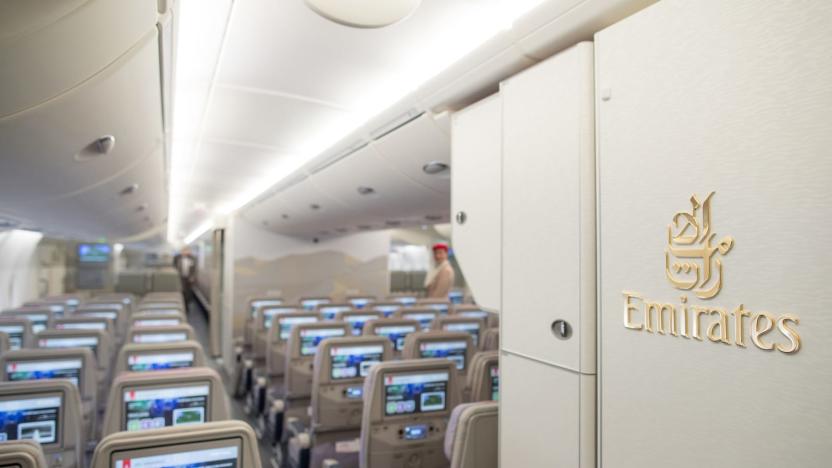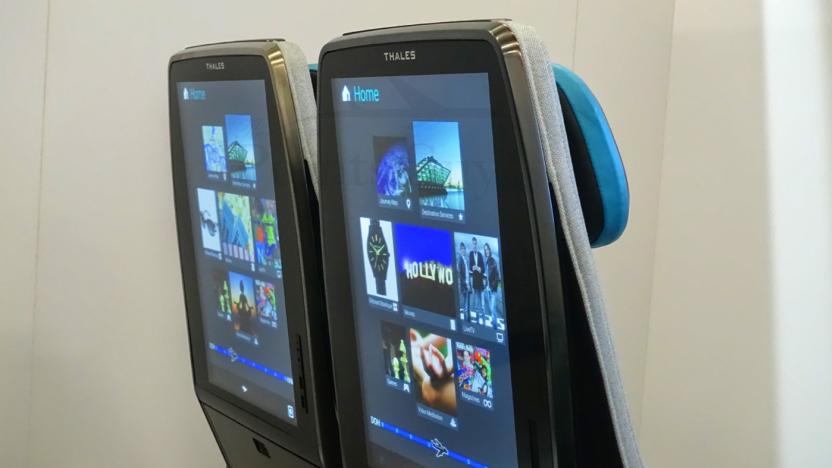Thales
Latest

Snapdragon 8 Gen 2 phones are the first to support built-in 'iSIMs'
Snapdragon 8 Gen 2 phones can now use 'iSIMs' that save space and money compared to eSIMs.

Two airlines are bringing faster WiFi to their international flights
Two airlines have made moves to upgrade their WiFi offerings today. Cathay Pacific Group will provide GoGo's 2Ku satellite-based broadband technology starting in 2018 and Emirates has partnered with Thales to bring 50Mpbs connectivity to its Boeing 777X fleet in 2020.

The future of air travel includes giant seatback displays
Airlines are increasingly embracing mobile devices for in-flight entertainment, and for a good reason -- a tablet is usually much nicer than the cramped, crude seatback systems you normally deal with. Thales thinks the industry can do better, though. It just previewed an in-flight entertainment system, Digital Sky, whose prototype gives each passenger a massive 21.3-inch touchscreen. The portrait orientation leads to some wasted space when you're watching videos, but it can do things that aren't realistic on tinier displays, like serving up the airline's magazine or highlighting things to do at your destination.

Robot agents will spare you from airport customs checks
If you're a frequent international flier, you know the pain of the customs check -- outside of the security inspection, it's one of the biggest hurdles you have to clear at the airport. You won't have to deal with it for much longer if Thales has its way. The electronics firm has developed a robot agent that not only checks you into your flight and prints tickets, but shares both a headshot and an iris scan with airport computers to verify whether or not you're a known threat. You wouldn't necessarily have to visit customs after landing in a new country -- you'd just leave the airport. Also, your boarding pass would include an encrypted version of that photo to save you the trouble of an ID inspection at the gate.

France and the UK want a fleet of minesweeping robot ships
The biggest threat to America's Navy over the past 60 years hasn't been China's rapidly modernizing military, North Korea's nuclear saber rattling or even Russia's arctic overtures -- it's been underwater mines. They've damaged 15 of our ships since 1950. Sure, you can disarm these explosive hazards manually but that means risking the lives of Navy seamen in an underwater Hurt Locker. Instead, the UK and France are teaming with European defense contractors Thales and BAE to develop a fully automated minesweeping system that keeps sailors out of harm's way.

UK investigating passive radar system to detect aircraft location, free up 5G spectrum
Ready for a new radar system? The UK could be, if a new study is deemed a success. Thales, a French aerospace company which manufactures traditional radar systems, has received funding from the UK's Technology Strategy Board to study the feasibility of using TV signals to locate planes and choppers through a technology called "passive radar." According to the BBC, the system would monitor the timing of TV signals reflected from aircraft, which would enable equipment to display an exact location, while measuring the Doppler effect would provide speed and direction information. Though it's not based on GPS, the new system would reportedly be more accurate and efficient than what's in use today, while also serving to free up spectrum that could be used for an upcoming 5G network. Unconvinced frequent fliers need not worry, however -- the country's existing radar infrastructure would remain intact throughout the test period, and air traffic control officials won't be switching to the new system unless it's sanctioned, which, considering the significance of such a move, could take some time.

Thales, Panasonic demo Android-based in-flight entertainment systems (video)
Never heard of Thales? Consider yourself schooled. Thales has been kicking the tires in the in-flight entertainment market for over a decade now, but there's no question that its latest innovation is the one that could take it the next level. Shown recently in Long Beach, the Touch Passenger Media Unit (TouchPMU) is one of the most intriguing uses of Android yet. The idea here is to use the 3.8-inch handset / controller in order to both view content and control what's happening on one's headrest television. The control itself is powered by an ARM Cortex processor and sports a capacitive touchpanel (800 x 480 resolution), support for Flash and 3D graphics. There's no telling when this stuff will actually be available on commercial flights (or when legacy airlines will ditch their World War II-era fleet), but it's safe to say that we're eager and ready for the future. Oh, and just in case anyone at Thales felt like resting on their laurels, it seems that Panasonic also has an Android-based IFEC system that it's showcasing, and a video of that just so happens to be waiting after the break.

Thales develops Indoor Positioning System based on UWB
Thales -- the French aerospace company that brought us MILTRAK -- has rolled out yet another impressive development, this time aiding firefighters, cops and armed forces in tracking objects / people while indoors. Its Indoor Positioning System (IPS) is essentially "an indoor form of satellite navigation," and while we've heard of similar, this iteration is based around ultra-wideband. Notably, the company implied that it hoped to bring the technology to police forces and military platoons in the future, and if things go smoothly, consumers could actually see it used in GPS-enabled mobiles in order to provide navigation services in more places. Unfortunately, it seems as though Thales is still working on completing the new system, so we wouldn't get all hopeful for a commercial release anytime soon.

MILTRAK gives soldiers the down low on encroaching enemy forces
We've seen a variety of systems designed to better inform soldiers of what's truly going on around them, but a new setup devised by Thales UK weds an advanced GPS module, a digital magnetic compass, a microprocessor, and a "fully ruggedized display" to provide near-real time situational awareness information. Dubbed MILTRAK, this concoction equips field soldiers with a portable display which seems to work an awful lot like your basic top-screen radar (think Counter-Strike), as it displays the positions of "similarly equipped friendly (blue) forces overlaid on a relational display, raster map, or geo-referenced aerial photograph." Moreover, those in battle can purportedly share and follow routes, which enhances communication and keeps platoons from running astray. Heck, they may even forget that the bullets flying around them are real.[Via TheRawFeed, image courtesy of Army]

MARIUS: emergency SMS alerts from helicopters
Officials taking advantage of the ubiquitous nature of cellphones to ensure the safety of the public is nothing new to us, but with its newest project, the European Commission is definitely taking it to a new level. The "Mobile Autonomous Reactive Information System for Urgency Situations" or MARIUS as it will be more affectionately referred, allows rescue teams to send SMS alerts from helicopters with built-in miniature wireless networks to areas, regardless of whether there is a functioning network in place. The project, which is being facilitated by the European Aeronautic Defence and Space Company (EADS), Thales, BAES, Selex, Eurocopter and Swapcom, is designed to allow for the rapid deployment of "autonomous Command Posts" which function in any sort of disaster. The project was successfully tested last month in a laboratory and July will mark the first one site testing in Valencia, Spain. It should be said though, while we definitely enjoy seeing technology used in this sort of capacity, it is does make us wonder where it will leave certain folks in such moments of crisis. [Via Textually]




